 |
Satish Lele lelepiping@gmail.com |
View this page as YouTube Video Presentation
- To produce electrical power, for example in power stations or in co-generation plants.
- To supply heat for heating in process systems.

Saturated steam used for heating gives up its latent heat (enthalpy of evaporation), which is a large proportion of the total heat that saturated steam contains. The remainder of the heat in the steam is retained in the condensate as sensible heat (enthalpy of water).

As well as having heat content, the condensate is basically distilled water, which is ideal for use as boiler feed water. An efficient steam system will collect this condensate and either return condensate to a deaerator, a boiler feed tank, or use condensate in another process. Only when there is a real risk of contamination should condensate not be returned to the boiler. Even then, it may be possible to collect the condensate and use condensate as hot process water or pass condensate through a heat exchanger where its heat content can be recovered before discharging the water to drain.
Condensate is discharged from steam plant and equipment through steam traps from a higher to a lower pressure. As a result of this drop in pressure, some of the condensate will re-evaporate into 'flash steam'. The proportion of steam that will 'flash off' in this way is determined by the amount of heat that can be held in the steam and condensate. A flash steam of 10% to 15% by mass is typical. However, the percentage volumetric change can be considerably more. Condensate at 7 bar g will lose about 13% of its mass when flashing to atmospheric pressure, but the steam produced will require a space some 200 times larger than the condensate from which steam was formed. This can have the effect of choking undersized trap discharge lines, and must be taken into account when sizing these trap discharge lines.
Calculating the amount of flash steam from condensate: Hot condensate at 7 bar g has a heat content of about 721 kJ/kg. When condensate is released to atmospheric pressure (0 bar g), each kilogram of water can only retain about 419 kJ of heat. The excess energy in each kilogram of the condensate is therefore 721 - 419 = 302 kJ. This excess energy is available to evaporate some of the condensate into steam, the amount evaporated being determined by the proportion of excess heat to the amount of heat required to evaporate water at the lower pressure, which in this example, is the enthalpy of evaporation at atmospheric pressure, 2,258 kJ/kg.

Proportion of flash steam using Figure

The amount of flash steam in the pipe is the most important factor when sizing trap discharge lines.
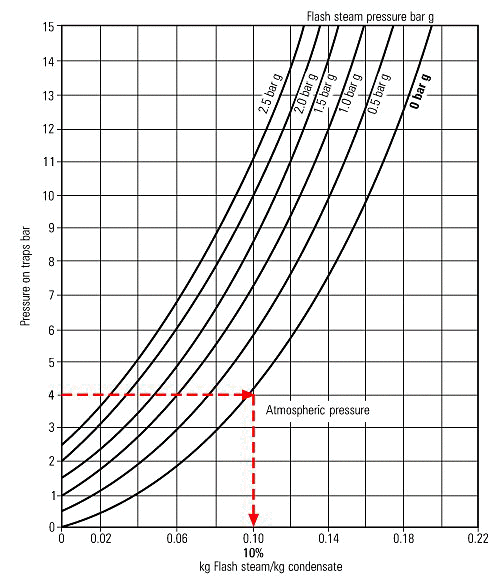
Steam produced in a boiler by the process of adding heat to the water is often referred to as live steam. The terms live steam and flash steam are only used to differentiate their origin. Whether steam is produced in a boiler or from the natural process of flashing, condensate has exactly the same potential for giving up heat, and each is used successfully for this purpose. The flash steam generated from condensate can contain up to half of the total energy of the condensate. An efficient steam system will recover and use flash steam. Condensate and flash steam discharged to waste means more make-up water, more fuel, and increased running costs.
The example will look at two essential areas - condensate management and flash steam recovery. Some of the apparent problem areas, will be outlined and practical solutions proposed.
The term 'trap' is used to denote a steam-trapping device, which could be a steam trap, a pump-trap, or a pump and trap combination. The ability of any trap to pass condensate relies upon the pressure difference across trap, whereas a pumping trap or a pump-trap combination will be able to pass condensate irrespective of operational pressure differences (subject to design pressure ratings).
Condensate return: An effective condensate recovery system, collecting the hot condensate from the steam using equipment and returning condensate to the boiler feed system, can pay for itself in a remarkably short period of time. Figure shows a simple steam and condensate circuit, with condensate returning to the boiler feed tank.
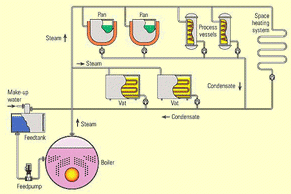
Why return condensate and reuse it?:
Financial reasons: Condensate is a valuable resource and even the recovery of small quantities is often economically justifiable. The discharge from a single steam trap is often worth recovering. Un-recovered condensate must be replaced in the boiler house by cold make-up water with additional costs of water treatment and fuel to heat the water from a lower temperature.
Water charges: Any condensate not returned needs to be replaced by make-up water, incurring further water charges from the local water supplier.
Effluent restrictions: Water above 43°C cannot be returned to the public sewer by law, because condensate is detrimental to the environment and may damage earthenware pipes. Condensate above this temperature must be cooled before condensate is discharged, which may incur extra energy costs. Similar restrictions apply in most countries, and effluent charges and fines may be imposed by water suppliers for non-compliance.
Maximizing boiler output: Colder boiler feed water will reduce the steaming rate of the boiler. The lower the feed water temperature, the more heat, and thus fuel needed to heat the water, thereby leaving less heat to raise steam.
Boiler feed water quality: Condensate is distilled water, which contains almost no total dissolved solids (TDS). Boilers need to be blown down to reduce their concentration of dissolved solids in the boiler water. Returning more condensate to the feed tank reduces the need for blow down and thus reduces the energy lost from the boiler.
Summary of reasons for condensate recovery:
Water charges are reduced.
Effluent charges and possible cooling costs are reduced.
Fuel costs are reduced.
More steam can be produced from the boiler.
Boiler blow down is reduced, so less energy is lost from the boiler.
Chemical treatment of raw make-up water is reduced.
The percentage of energy in condensate to that in steam can vary from 18% at 1 bar g to 30% at 14 bar g, clearly the liquid condensate is worth reclaiming.
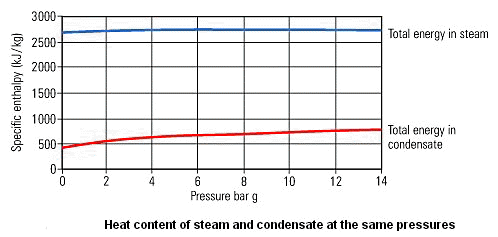
Determine the payback period
Total Saving = Fuel saving + Water saving + effluent reduction
Payback Period = Cost of Project / Annual Savings = 35 weeks.
Steam is common and convenient mode to convey energy and is used in almost all major industrial processes. Steam economy greatly depends on delivering the steam through properly designed steam distribution lines. It is essential to adopt all possible measures including new technologies to optimize the steam distribution costs.
Steam is used to provide process heat and mechanical power. Steam loss in the process, is a major problem faced by industries. A well designed steam distribution system can reduce the losses and improve the efficiency of the steam system thus reducing energy costs. The function of the steam distribution system is to get the steam to where steam is needed and return the condensate to the boiler, doing both as efficiently as possible. Distribution heat losses account for 3 to 10% of the total energy generated in a boiler system. Energy management can reduce the heat loss by improving the insulation, detecting and repairing steam and condensate leaks, maintaining the steam traps and condensate pumps, and providing water treatment. A well designed steam distribution network can improve the efficiency of the steam system. For optimum performance of the distribution and steam end use equipment, a supply of right quantity and quality of steam is of vital importance. The losses in the steam distribution system can be in the form of:
Radiation and convection.
Pressure losses in the distribution pipe lines.
- Steam leaks in joints, valves, gauges, etc.
Steam losses due to improper selection, incorrect location, wrong positioning and malfunctioning of traps.
Inappropriate location and capacity of air vents.
Poor dryness fraction of steam.
Steam losses due to external leakages can easily be identified. Such leakages can be plugged using online sealing techniques. The valves in the bypass around the steam traps as well as mal-functioning steam traps are the prime sources of internal leakages. These are difficult to detect as they are hidden and invisible in the flash steam. It is, therefore essential to improve the steam distribution system. Following are some important aspects to be taken care of:
Properly select, size, and maintain the distribution system and steam traps.
Insulate all distribution system pipes, flanges, and valves.
Ensure that steam mains are properly laid out, sized, adequately drained, and adequately air vented.
Ensure that distribution system piping is correctly sized to maintain appropriate system pressure drops.
Ensure that distribution system piping is adequately supported, guided, and anchored; and that appropriate allowances are made for pipe expansion at operating temperatures.
A practical steam distribution system should necessarily compromise between the above ideal conditions and several other factors. Lack of attention to these will significantly increase operating costs, either because of reduction in overall efficiency or increase in maintenance costs or both.
Steam piping layout: Steam piping transports steam from the boiler to the end-use services. Important characteristics of a well designed steam system piping are that, it is adequately sized, configured, and supported. Installations of larger pipe diameters could be more expensive, but can reduce the pressure drop for a given flow rate and also help to reduce the noise associated with steam flow. Hence, one consideration should be given to the type of environment in which the steam piping will be located when selecting the pipe diameter.
Important configuration issues are flexibility and drainage. Piping, especially at equipment connections, needs to accommodate thermal reactions during systems start-ups and shutdowns. Piping should be equipped with a sufficient number of appropriately sized drip legs to promote effective condensate drainage and should be pitched properly to promote the drainage of condensate to these drip lines. Typically, these drainage points experience two very different operating conditions, viz., normal operation and start-up. Both load conditions should be considered in the initial design. Mechanical type moisture separators with traps should be provided in piping at interval, to separate the fine moisture particles in the steam. Automatic air vents should be fixed at the dead end of steam mains to allow removal of air / non-condensable which tends to accumulate in steam space.
Steam pipe sizing and redundancy: Proper sizing of the steam pipelines involves selecting a pipe diameter which gives acceptable pressure drop between the boiler and the user. Pipe sizing can be done either based on the velocity or on the desired pressure-drop. Pipe sizing can be done from the general recommendations on line velocities of different fluid based on the specific volume of steam for the chosen distribution pressure and quality of steam, whether wet or superheated. The velocities for various types of steams are:
- Superheated 50-70 m/sec
- Saturated 30-40 m/sec
- Wet or Exhaust 20-30 m/sec
Unused steam piping experiences the same losses as the rest of the system. It is therefore imperative to isolate the unused steam lines immediately. Pipe routing is made for transmission of steam in the shortest possible way, so as to reduce the pressure drop in the system.
Steam pressure: The steam distribution pressure should be adjusted in accordance with the pressure generated and the pressure required at the consumer side. If steam piping already exists then the pressure should be adjusted for lower operating cost. However, at the designing stage, it is desirable to consider steam distribution at the same pressure as the source, or at a moderately high intermediate pressure, if the generation is at very high pressure. Distribution of the steam at the same pressure that of source has the following advantages:
- The steam velocity along and within the pipes will be lowered and this reduces both noise and erosion.
- It provides stable pressure at the user end due to lower pressure drop and higher operating margins.
- The capital cost is reduced as the pipe line is smaller in size. Nonetheless, for long distribution systems, it is economical to super-heat the steam to minimize the steam losses. The piping needs to be properly sized and well insulated.
Estimating pressure requirements for small distribution systems is relatively simple, it should just meet the minimum user requirement, unless future expansion of the system or new equipment requiring higher pressures is envisaged. For systems where only a small quantity of high pressure steam is actually required, but where large quantities of low pressure steam are used, the possibility of separating the two should be considered.
Insulation: Heat losses through the surface of the steam distribution pipes can significantly increase energy use and cost. Good engineering design of insulation system will reduce undesirable heat loss and will often improve environmental condition. Poorly insulated / un-insulated steam distribution and condensate return lines are a constant source of wasted energy. A good and proper insulation can typically reduce energy losses by 90% and help to ensure proper steam quality and pressure at plant equipment. Insulation would also reduce leakages and other issues due to erosions or water hammering due to excessive condensate in steam.
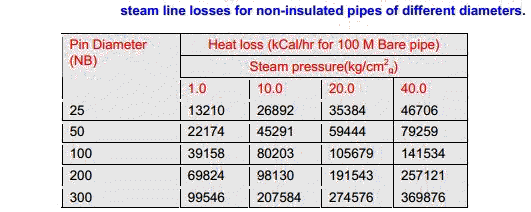
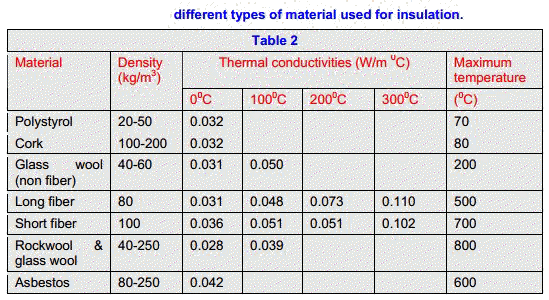
Economical Insulation Thickness: As the thickness of the insulation increases, the cost of material and installation also goes up. The cost of lost energy, on the other hand, goes down up to a certain thickness. Above this thickness, the gains due to drop in the surface temperature are compensated with increase in the surface area of the insulation. In other words, the energy saving also goes up, but at a slower rate of increase than the cost of the materials and installation.
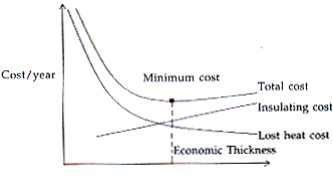
At a particular point, the total cost, which is the sum of cost of lost energy and the material cost, reaches a minimum point. It is the economic thickness of insulation. Figure illustrates the method of determining the economic thickness. The recommended insulation thickness for mineral wool, which is commonly used in various industries.
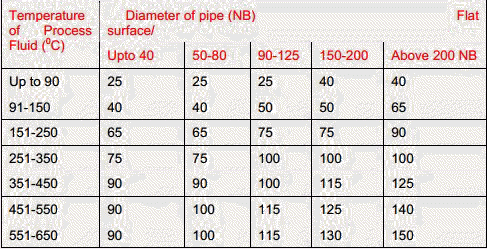
Major factors determining insulation selection are:
- Operating temperature.
- Thermal conductivity of the insulating material.
- Resistance to heat, weather, and adverse atmospheric conditions.
- Ability to withstand vibration, noise, and mechanical damage.
- Resistance to chemicals / environment.
- Resistance to fire.
- Extent of shrinking or creaking during use.
- Jacking for insulation
Steam Traps and strainers: As steam moves throughout the system, steam looses a small part of heat through surfaces, due to condensation. The condensate, traveling at over 200 km / hr may erode the pipe lines (especially at bends and partially in open valves) and even lead to water hammering and can damage equipment, if not removed effectively. Steam traps are automatic valves that separate condensate from the steam. A leaky trap wastes energy by allowing steam to enter the condensate return. A mal-functioning trap may not expel the condensate from the steam line, thus reducing efficiency of the system.
Steam traps are classified into three main groups: mechanical, thermostatic, and thermodynamic, with several different types of traps in each group. It is essential to understand the operations and functions of the traps and carefully read the instructions, since the traps operate in different ways and sizes, as positioning and installation procedures vary.
Selection of steam traps: Selection of an appropriate trap should be made based on the capacity curve of the trap, which varies with every manufacture. Due care must be taken to understand loading, normal as well start up and differential pressure across the trap, type of applications, possibility of non-condensable in condensate, while selecting the type and model of the trap. A selected model may preferably be somewhere midway of the capacity curve.
Steam trap leakage: Leakage in the steam traps allows the steam to blow into the condensate system which is then vented to the atmosphere. A regular inspection must be carried out for steam traps and valves and leaks should be attended to immediately.
Strainers: Performance of steam traps decreases due to dirt and scale accumulation. To eliminate this problem it is essential to install pipe-line strainer. Strainers are fitted before the traps, if the traps do not have built-in trap strainer. It is advisable to check the strainers at regular intervals.
Water hammer: One of the most common complaints is that a system sometimes develops a hammer-like noise commonly referred to as water hammer. Water hammer in steam lines is normally caused by the accumulation of condensate. It may indicate a condition which could produce serious consequences including damaged vents, traps, regulators and piping. Two types of water hammer can occur in steam systems:
The first type is usually caused by the accumulation of condensate (water) trapped in a portion of horizontal steam piping. The velocity of the steam flowing over the condensate causes ripples in the water. Turbulence builds up until the water forms a solid mass, or slug, filling the pipe. This slug of condensate can travel at the speed of the steam and will strike the first elbow in its path with a force comparable to a hammer blow. In fact, the force can be great enough to break the back of the elbow.
The second type of water hammer is actually cavitation. This is caused by a steam bubble forming or being pushed into a pipe completely filled with water. As the trapped steam bubble looses its latent heat, the bubble collapses, the wall of water comes back together and the force created can be severe. This condition can crush float balls and destroy thermostatic elements in steam traps. Cavitation is the type of water hammer that usually occurs in condensate return lines or pump discharge piping.
Precautions to prevent water hammer in steam lines are:
Steam pipes must be pitched away from the boiler towards a drip trap station. Drip trap stations must be installed ahead of any risers, at the end of the main and every 100 to 150 meters along the steam piping.
Drip traps must be installed ahead of all steam regulator valves to prevent the accumulation of condensate when the valve is in a closed position.
“y” strainers installed in steam lines should have screen and dirt pocket mounted horizontally to prevent condensate from being collected in the screen area and being carried along in slugs when steam flow occurs.
All equipment using a modulation regulator on the steam supply must provide gravity condensate drainage from the steam traps. Lifts in the return line must be avoided.
Another type of loss observed in steam traps, occurs when hot or pressurized condensate passes through the traps and the water flashes off a certain percentage of the steam due to instant pressure change. This is called ‘Flash steam loss’. In this case it is recommended to use pressurized condensate recovery system and / or flash steam recovery system for complete recovery of thermal energy.
Steam quality: The quality of steam also determines the performance of steam distribution system. Good quality steam means dry moisture-free steam, free from air, carbon dioxide and other non-condensable matter.
Moisture in steam: Saturated steam generated in packaged boiler contains 2 to 5% moisture, while steam from coil type non IBR boilers could have 10 to 60% moisture. Super-heated steam on the other hand does not contain any moisture. However, some moisture is picked up while de-superheating the steam. The steam also gives away latent heat and becomes wet, while being transported through distribution system. The wet steam contains particles of water droplet which have not evaporated. These droplets do not contribute to heat transfer and it is essential to remove droplets from the steam. A moisture separator at the entrance of the equipment separates the droplets and drains them through traps. The wetness can also be reduced by resorting to pressure reduction of steam prior to its use.
Non-condensable in steam: Dissolved oxygen in the boiler feed water, if not removed properly, gets carried away with the steam. The bicarbonate salts in the feed water generate carbon dioxide which is also transported with the steam. The problems associated with non-condensable.
Reduction in the heat transfer area to the extent of space occupied.
Drop in heat transfer rate due to reduction in effective steam temperature (based on the partial pressure of the steam in the steam air mixture).
Additional resistance to heat transfer due to formation of barrier layer.
It is therefore very important to remove the non-condensables through air vents provided at proper location and also installing appropriate type of steam trap.
Salient Points:
- Replace damaged / wet insulation
- Avoid steam leakages.
- Provide dry steam for process.
- Utilizing steam at lower acceptable pressure for the process.
- Ensure proper utilization of directly injected steam.
- Minimize heat transfer.
- Use condensate recovery system.
- Insulate all steam pipelines and hot process equipment.
- Recover flash steam.
- Maintain at least 125 mm per meter of falling slope for steam piping.
- Provide drain points at lower points in the main and where the steam main rises.
- Drain points in the main lines should be through an equal tee connection only.
- The branch lines from the mains should always be connected at the top.
- Insure supports as well as an alternation in level can lead to formation of water pockets in steam, leading to wet steam delivery.
 to get all the information as a eBook
to get all the information as a eBook
